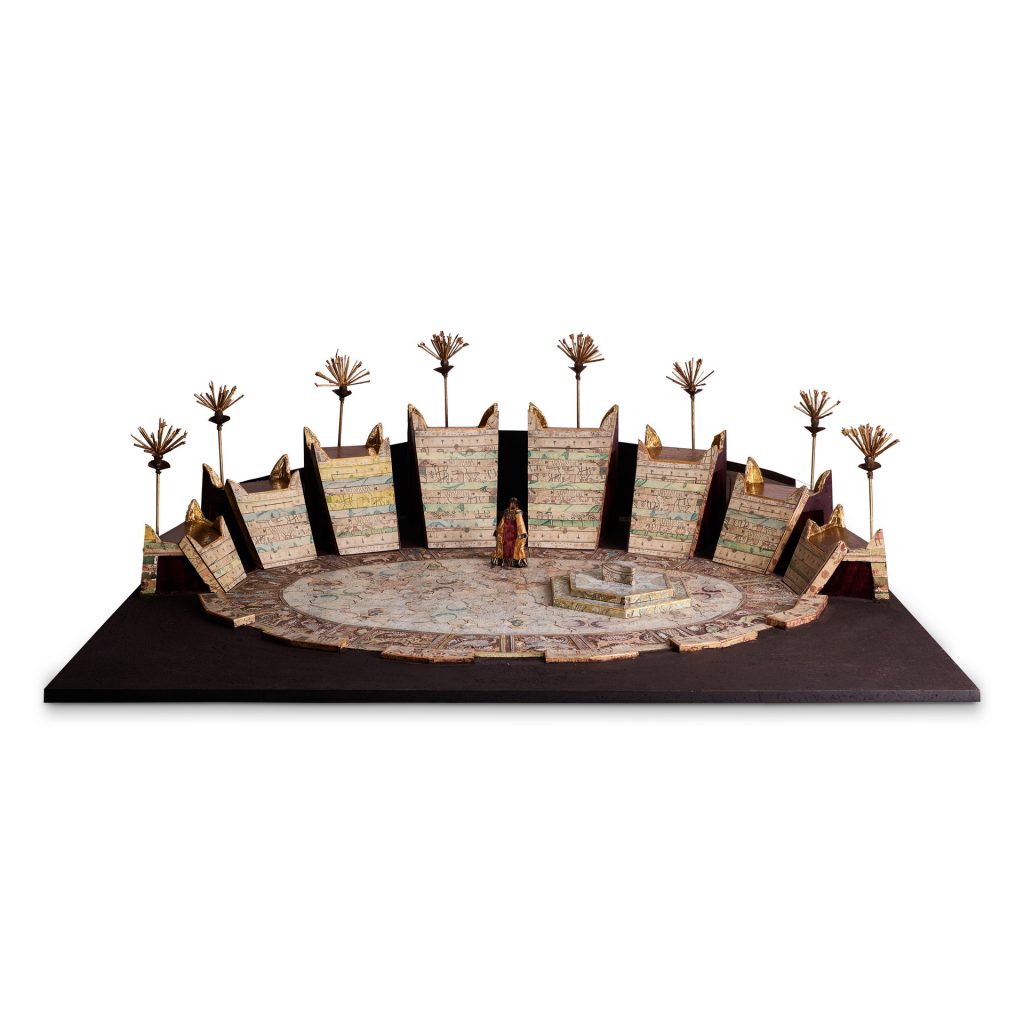Aryeh Navon (1909-1996)
Set design model for the musical King Solomon and Shalmai the Cobbler
Israel, 1981
Mixed media
Courtesy of the Theater Archive, Tel Aviv University
Must Know
In 1964 the Cameri Theater successfully revived Sammy Gronemann’s play King Solomon and Shalmai the Cobbler. The play already had a hebrew version, adapted by Nathan Alterman in 1942, commissioned by Ohel Theater. The play’s plot is based on several stories and myths from the Bible and the Midrash concerning King Solomon.
The Cameri asked Alterman to rework his adaptation and add several songs. The play was directed by Shmuel Bonim; Sasha Argov wrote the music; Anna Sokolow was the choreographer; and the minimalist set was designed by Aryeh Navon. Actor Illy Gorlitzki played the roles of Solomon and Shalami, Yona Atari played Na’ama, the cobbler’s wife, and Rachel Atas was cast in the role of the Egyptian mistress, Nofrit.
In the 1960s, director Shmuel Bunim came up with the idea to turn the play of the 1940s into an original Israeli musical. The poet Nathan Alterman was excited about this idea and wrote 12 new songs which were then composed by Sasha Argov. As usual, Alterman was present at the rehearsals and sometimes he was working on texts on the spot. Many songs composed by Argov had become hits sung by many people. Alterman’s refrains and rhymes were composed of witty wordplays and puns. The language of the play is rich in Biblical references and its hebrew is scholarly and poetic, but at the same time, it contains everyday words and slang, filled with humor that is sometimes folksy and sometimes subtle. The language corresponds with the message that the play conveys: social division into classes. The most important source of inspiration for the story of the play (originally called The Wise and the Fool) are the stories of King Solomon in Rabbinical literature. For instance, the story of the demon king Ashmadai, who took over the throne for a period while Solomon was wandering as a beggar, and after that Solomon expelled him back to hell.
Arieh Navon (1909-1996) illustrated dozens of books, among others the books of Nathan Alterman, Avraham Shlonsky, Leah Goldberg, Shmuel Josef Agnon, Moshe Shamir, Aharon Megged, Haim hefer, and stories from the Bible. he also illustrated the first animated film in hebrew, The Adventures of Gadi Ben Sussi. From 1948, he designed sets for all theatres, mainly for the Cameri, Habima, and for the Haifa Theatre. Director Shmuel Bunim said of him: “he designed implicit, minimalistic and clever stages, the switches between the palace pictures and the market pictures were done easily, quickly and with humor, and these contributed to the flow and the rhythm of the show”. As an illustrator and caricaturist, Navon developed the ability to portray reality with a minimum of lines and gave up on size and depth. he identified the characteristic and essential elements in a piece of reality, event, or a certain person, and knew how to emphasize them in a concise manner so that an amusing, as well as critical, impression will be created. The musical backdrop of the play is characterized by colors and textures. The play deals with the effect of a person’s appearance on his role and status in his own eyes and in the eyes of others, and Navon “dressed” the stage so that once it would represent a kingdom, and once create the experience of a market. The royal richness was represented by glancing and glamorous bodies, while the market by hanging up colorful and torn sheets that filled the space on the stage with a lively mixture of these two.
More Info
Despite the first harsh critique, the show ran almost every evening for three years, and was performed more than 600 times. In total, the play was performed over 1,000 times, including shows in Paris, London, and Montreal. The show was sent to represent Israel in the world and won many awards. The show had a phonograph record too that itself became a bestseller when thousands of copies had been distributed and had increased the popularity of the hits. It was the first time that a hebrew play had merchandise like in the USA. During the 1960s, producer Menahem Golan tried to create an epic film based on the successful musical. If the project had materialized, it would have been the most expensive film ever made by Israeli cinema, and maybe at the same level as the Biblical films being made abroad. However, Golan’s efforts ended with a failure. Despite the fact that the film was originally written in German and was only translated into hebrew by Alterman, it received the Council for Culture and Arts Award for the Best Original Play.

